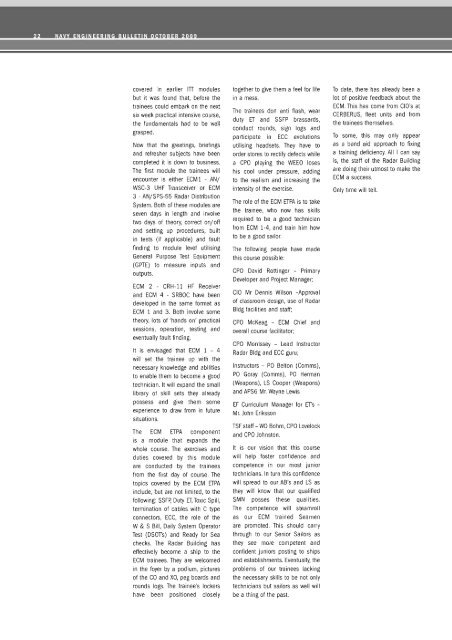ENGINE - Royal Australian Navy
ENGINE - Royal Australian Navy
ENGINE - Royal Australian Navy
Create successful ePaper yourself
Turn your PDF publications into a flip-book with our unique Google optimized e-Paper software.
covered in earlier In modules<br />
but it was found that, before the<br />
trainees cou ld embark on the next<br />
six week practical intensive course,<br />
the fundamentals had to be well<br />
grasped.<br />
Now that the greetings, briefings<br />
and refresher subjects have been<br />
completed it is down to business.<br />
The first module the trainees will<br />
encounter is either ECM 1 - AN/<br />
WSC-3 UHF Transceiver or ECM<br />
3 - AN/SPS-55 Radar Distribution<br />
System. Both of these modules are<br />
seven days in length and involve<br />
two days of theory, correct on/ off<br />
and setting up procedures, built<br />
in tests (if applicable) and fault<br />
finding to modu le level utilising<br />
General Purpose Test Eq uipment<br />
(GPTE) to measure inputs and<br />
outputs.<br />
ECM 2 - CR H-1 1 HF Receiver<br />
and ECM 4 - SRBOC have been<br />
developed in the same format as<br />
ECM 1 and 3. Both involve some<br />
theory, lots of 'hands on' practica l<br />
sessions, operation, testing and<br />
eventually fault finding.<br />
It is envisaged that ECM 1 - 4<br />
will set the trainee up with the<br />
necessary knowledge and abilities<br />
to enable them to become a good<br />
technician. It will expand the sma ll<br />
library of skil l sets they already<br />
possess and give them some<br />
experience to draw from in futu re<br />
situations.<br />
The ECM ETPA component<br />
is a module that expands the<br />
whole course. The exercises and<br />
duties covered by this module<br />
are conducted by the trainees<br />
from the first day of course. The<br />
topics covered by the ECM ETPA<br />
include, but are not limited, to the<br />
following: SS Fp, Duty ET, Toxic Spill,<br />
termination of cables with C type<br />
connectors, ECC, the role of the<br />
W & S Bill, Daily System Operator<br />
Test (DSOT's) and Ready for Sea<br />
checks. The Radar Building has<br />
effectively become a ship to the<br />
ECM trainees. Th ey are welcomed<br />
in the foyer by a podium, pictures<br />
of the CO and XO, peg boards and<br />
rounds logs. The trainee's lockers<br />
have been positioned closely<br />
together to give them a feel for life<br />
in a mess.<br />
The trainees don anti flash , wear<br />
duty ET and SSFP brassards,<br />
conduct rounds, sign logs and<br />
participate in ECC evolutions<br />
utilising headsets. Th ey have to<br />
order stores to rectify defects while<br />
a CPO playing the WEEO loses<br />
his cool under pressure, add ing<br />
to the realism and increasing the<br />
intensity of the exercise.<br />
The role of the ECM ETPA is to take<br />
the tra inee, who now has skills<br />
required to be a good technician<br />
from ECM 1-4, and train him how<br />
to be a good sailor.<br />
The following people have made<br />
this course possible:<br />
CPO David Rottinger - Primary<br />
Developer and Project Manager;<br />
CIO Mr Dennis Wilson -Approval<br />
of classroom design, use of Radar<br />
Bldg facilities and staff;<br />
CPO McKeag - ECM Chief and<br />
overall course facilitator;<br />
CPO Morrissey - Lead Instructor<br />
Radar Bldg and ECC guru;<br />
Instructors - PO Belton (Comms),<br />
PO Goray (Comms), PO Herman<br />
(Weapons), LS Cooper (Weapons)<br />
and APS6 Mr. Wayne Lewis<br />
EF Curriculum Manager for ET's -<br />
Mr. John Eriksson<br />
TSF staff - WO Bohm, CPO Lovelock<br />
and CPO Johnston.<br />
It is our vision that this course<br />
will help foster confidence and<br />
competence in our most junior<br />
technicians. In turn this confidence<br />
will spread to our AB's and LS as<br />
they will know that our qualified<br />
SMN posses these qualities.<br />
Th e competence wi ll steamroll<br />
as our ECM trained Seamen<br />
are promoted. This should carry<br />
through to our Sen ior Sailors as<br />
they see more competent and<br />
confident j uniors posting to ships<br />
and establishments. Eventually, the<br />
problems of our trainees lacking<br />
the necessary skills to be not only<br />
technicians but sailors as well will<br />
be a thing of the past.<br />
To date, there has already been a<br />
lot of positive feedback about the<br />
ECM. This has come from CIO's at<br />
CERBERU S, fleet units and from<br />
the trainees themselves.<br />
To some, this may on ly appear<br />
as a band aid approach to fixing<br />
a training deficiency. All I can say<br />
is, the staff of the Radar Building<br />
are doing their utmost to make the<br />
ECM a success.<br />
Only time will tell.

















